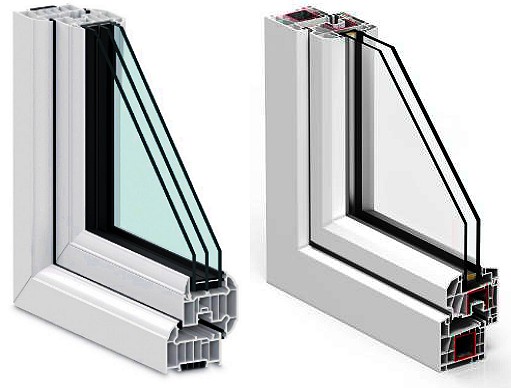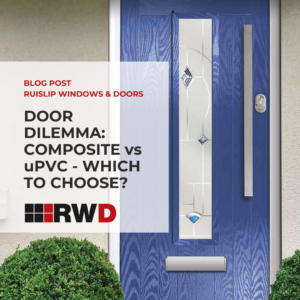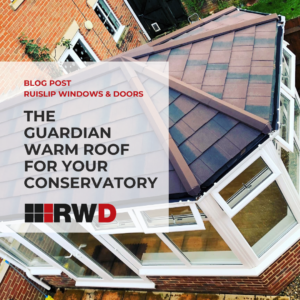Double glazing vs triple glazing: what’s the best option? 🏡
Triple-glazing is often marketed as a better option than double-glazing, especially when it comes to thermal insulation. But is this really the case?
Here we attempt to debunk many of the myths that surround triple glazing, and clarify the facts to help you make an informed decision that’s right for you.

Example of a triple glazed sealed unit and a double glazed sealed unit.
Whilst it’s true that triple-glazing does offer benefits, it may not be the best or most economic solution for you.
Q: Is triple glazing is a better insulator for your home than double glazing?
The energy performance of windows is measured in U-Values. Lower U-values = a more energy efficient window. Traditional single glazed windows can have a U value in excess of 5! Since the 15th June 2022, Building Regulations stipulate that modern double glazing should have a U-value of 1.4W/m2k (or Window Energy Rating B).
U-Values for older double glazing used to be much higher. However in recent years the manufacturing process has been greatly improved to provide much more energy efficient units. These improvements have been brought about by the introduction of wider cavities between the two glass panes, low-emissivity coatings being added to the glass to stop heat escaping (glass such as Pilkington K or Planitherm Softcoat Total), the cavity being filled with an inert gas (usually argon) and the use of warm-edge spacer bars (instead of aluminium).
Triple-glazing enables window manufacturers to achieve U-values of 1.0 and lower. So yes, triple glazing can enhance heat retention. But such U-values are really only of benefit when they are installed into an overall energy saving build, such as in a low energy house or a “passive house”. Where windows are being fitted into a standard build or as part of a refurbishment project then sealed units offering U-values as low as 1.1 are preferable and easily achievable with double glazing.
With the exception of perhaps areas of Scotland, the rest of the UK is not usually cold enough to warrant the use of triple glazing. Scandinavian countries such as Iceland, Sweden, Norway, Finland and other far northern countries use triple glazing because temperatures such as -20°c can be quite frequent. Highly energy efficient windows and doors, triple and sometimes quadruple-glazed are absolutely necessary to help reinforce the fabric of the buildings against the cold.
As far as the UK is concerned, there are many who argue that triple glazing simply doesn’t make sense in our climate. It is more costly to produce, produces much heavier sections and has an embodied energy approximately 50% higher than double glazing. Why would home owners pay more when good double glazed windows would easily tick the box?
Q: Is triple glazing is a better sound insulator than double glazing?
One of the biggest selling points of triple glazing has been its ability to reduce noise and outdoor sound. The thickness of the glass used is one of the three key elements of the sound insulation. Different thicknesses of glass will block a different frequency, so a combination of panes of varying thickness is more effective at keeping noise out. This is known as asymmetrical glazing. However, (and somewhat ironically!) most fabricators currently appear to offer triple glazed units with standardised cavities and glass thicknesses.
The second key element is the size of the gap between the panes. The larger the gap, the better the overall sound insulation effect. Finally the use of an acoustical resistant gas to augment or replace the inert gas (usually argon) will effectively help reflect noise away.
If sound insulation is important to you then it would be worth considering acoustic glass sealed units (such as Pilkington Optiphon or St Gobain’s acoustic glass, both of which are laminates) or even secondary double glazing instead. Secondary glazing will have a much greater air gap than can be achieved in triple glazing, and can achieve great noise reduction at considerably less cost, however any noise reduction is lost once you open the window.
In conclusion – For:
- Triple-glazing offers low U-values suited to specific low-energy and “passive house” projects and can return the value of your investment when fitted as part of these specifications.
- If asymmetrical glazing is used together with acoustic glass, additional noise reduction can be achieved.
- Triple glazing doesn’t offer extra features over double glazing, it simply enhances what is already there. This means better energy efficiency, noise reduction, strength and security.
In conclusion – Against:
- Higher cost.
- Reduced light penetration due to additional layer of glass.
- Minimal savings in energy bills in comparison to the higher cost.
- Benefits such as noise reduction and solar control can be included in double-glazing for less than the cost of a standard triple-glazed unit.
- Overall greater weight than a double glazed unit could pose problems for your windows – sashes dropping can be an issue.
Please do not hesitate to contact us for any further information. We look forward to hearing from you and hope to see you soon! 🙂




One thought on “Double glazing vs triple glazing: what’s the best option? 🏡”